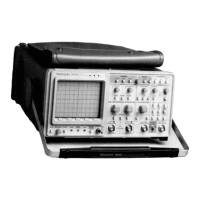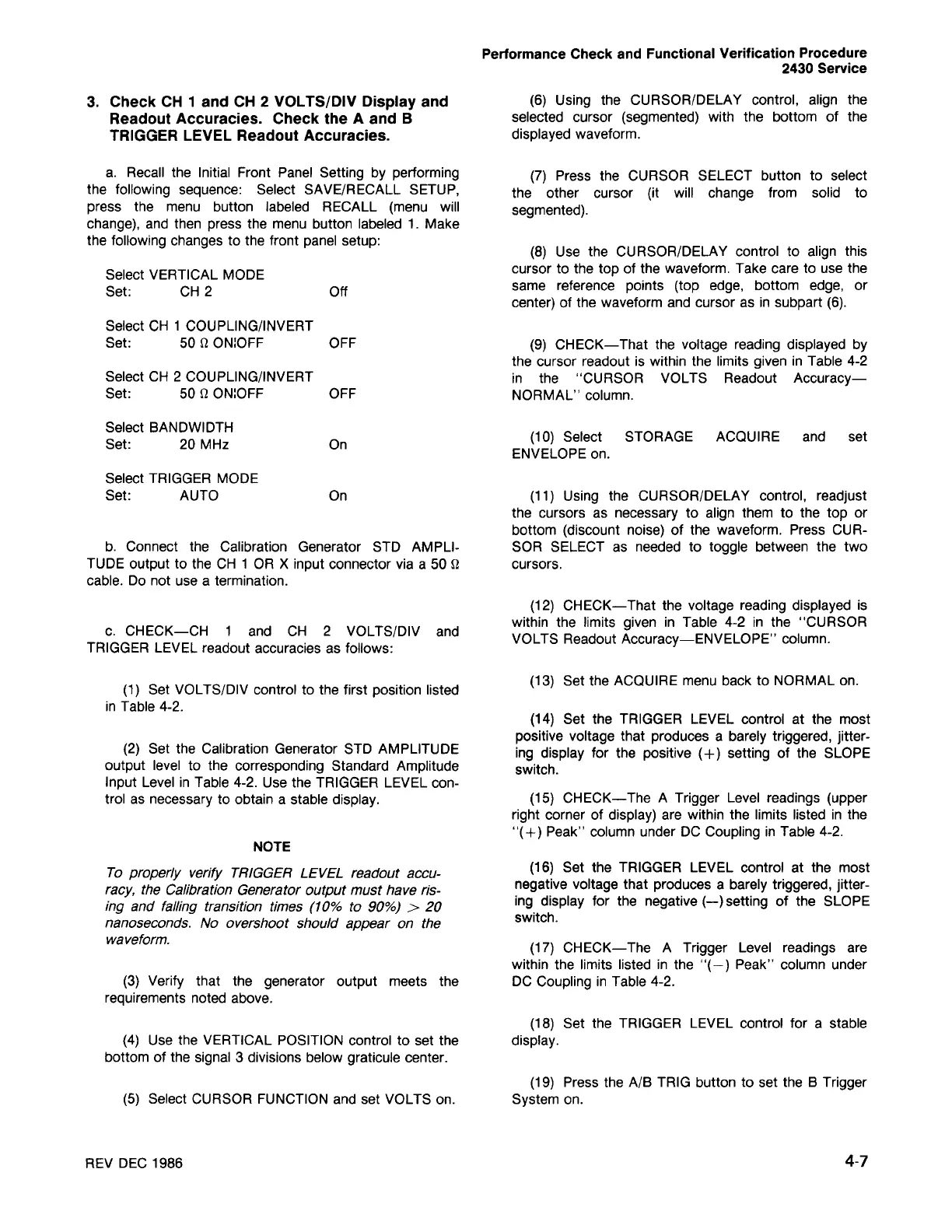4-7
(19) Press the A/B TRIG button to set the B Trigger
System on.
(18) Set the TRIGGER LEVEL control for a stable
display.
(17) CHECK-The A Trigger Level readings are
within the limits listed in the "( -) Peak" column under
DC Coupling in Table 4-2.
(16) Set the TRIGGER LEVEL control at the most
negative voltage that produces a barely triggered, jitter-
ing display for the negative (-) setting of the SLOPE
switch.
(15) CHECK-The A Trigger Level readings (upper
right corner of display) are within the limits listed in the
"(+)
Peak" column under DC Coupling in Table 4-2.
(14) Set the TRIGGER LEVEL control at the most
positive voltage that produces a barely triggered, jitter-
ing display for the positive
(+)
setting of the SLOPE
switch.
(13) Set the ACQUIRE menu back to NORMAL on.
(12) CHECK-That the voltage reading displayed is
within the limits given in Table 4-2 in the "CURSOR
VOLTS Readout Accuracy-ENVELOPE" column.
(11) Using the CURSOR/DELAY control, readjust
the cursors as necessary to align them to the top or
bottom (discount noise) of the waveform. Press CUR-
SOR SELECT as needed to toggle between the two
cursors.
(10) Select STORAGE ACQUIRE and set
ENVELOPE on.
(9) CHECK-That the voltage reading displayed by
the cursor readout is within the limits given in Table 4-2
in the "CURSOR VOLTS Readout Accuracy-
NORMAL" column.
(8)
Use the CURSOR/DELAY control to align this
cursor to the top of the waveform. Take care to use the
same reference points (top edge, bottom edge, or
center) of the waveform and cursor as in subpart (6).
(7)
Press the CURSOR SELECT button to select
the other cursor (it will change from solid to
segmented).
(6) Using the CURSOR/DELAY control, align the
selected cursor (segmented) with the bottom of the
displayed waveform.
Performance Check and Functional Verification Procedure
2430 Service
REV DEC 1986
(5) Select CURSOR FUNCTION and set VOLTS on.
(4) Use the VERTICAL POSITION control to set the
bottom of the signal 3 divisions below graticule center.
(3) Verify that the generator output meets the
requirements noted above.
NOTE
To properly verify TRIGGER LEVEL readout accu-
racy, the Calibration Generator output must have ris-
ing and falling transition times (10% to 90%)
>
20
nanoseconds. No overshoot should appear on the
waveform.
(2) Set the Calibration Generator STD AMPLITUDE
output level to the corresponding Standard Amplitude
Input Level in Table 4-2. Use the TRIGGER LEVEL con-
trol as necessary to obtain a stable display.
(1) Set VOLTS/DIV control to the first position listed
in Table 4-2.
c. CHECK-CH and CH 2 VOLTS/DIV and
TRIGGER LEVEL readout accuracies as follows:
b. Connect the Calibration Generator STD AMPLI-
TUDE output to the CH 1 OR X input connector via a 50
n
cable. Do not use a termination.
On
Select TRIGGER MODE
Set: AUTO
On
Select BANDWIDTH
Set: 20 MHz
Select CH
2
COUPLING/INVERT
Set: 50
n
ON:OFF OFF
Select CH
1
COUPLING/INVERT
Set: 50
n
ON:OFF OFF
Select VERTICAL MODE
Set: CH 2 Off
a. Recall the Initial Front Panel Setting by performing
the following sequence: Select SAVE/RECALL SETUP,
press the menu button labeled RECALL (menu will
change), and then press the menu button labeled 1. Make
the following changes to the front panel setup:
3. Check CH 1 and CH 2 VOL TS/DIV Display and
Readout Accuracies. Check the A and B
TRIGGER LEVEL Readout Accuracies.

